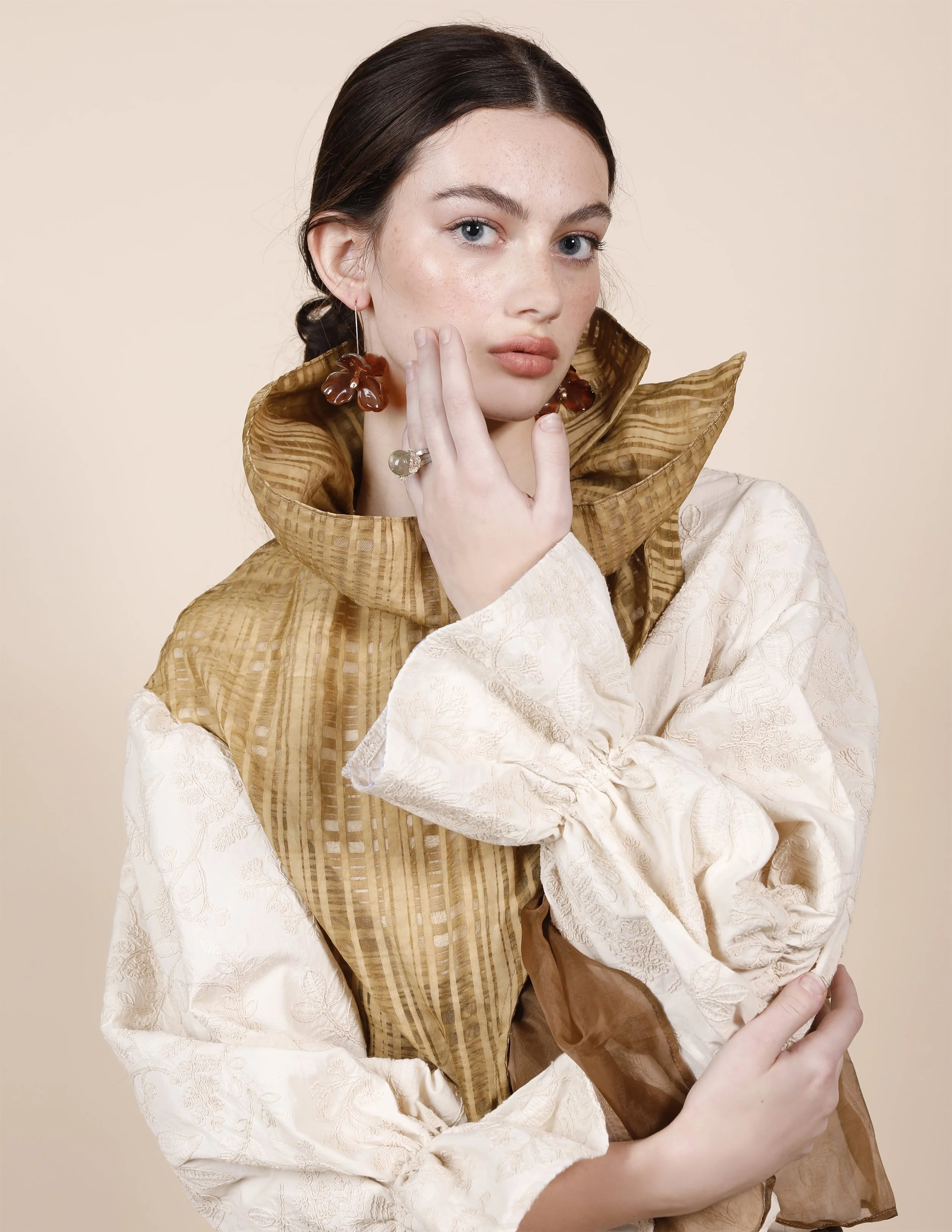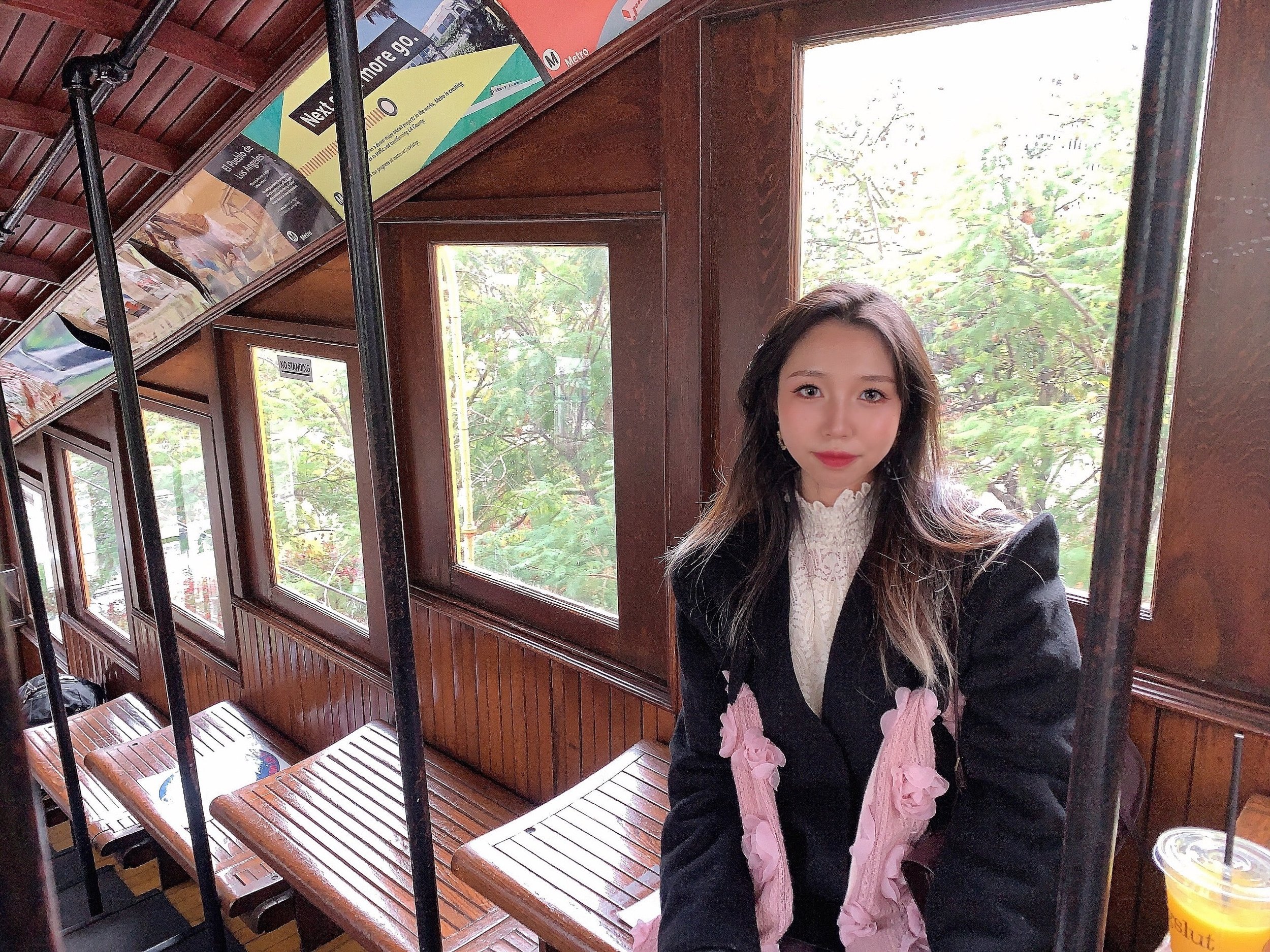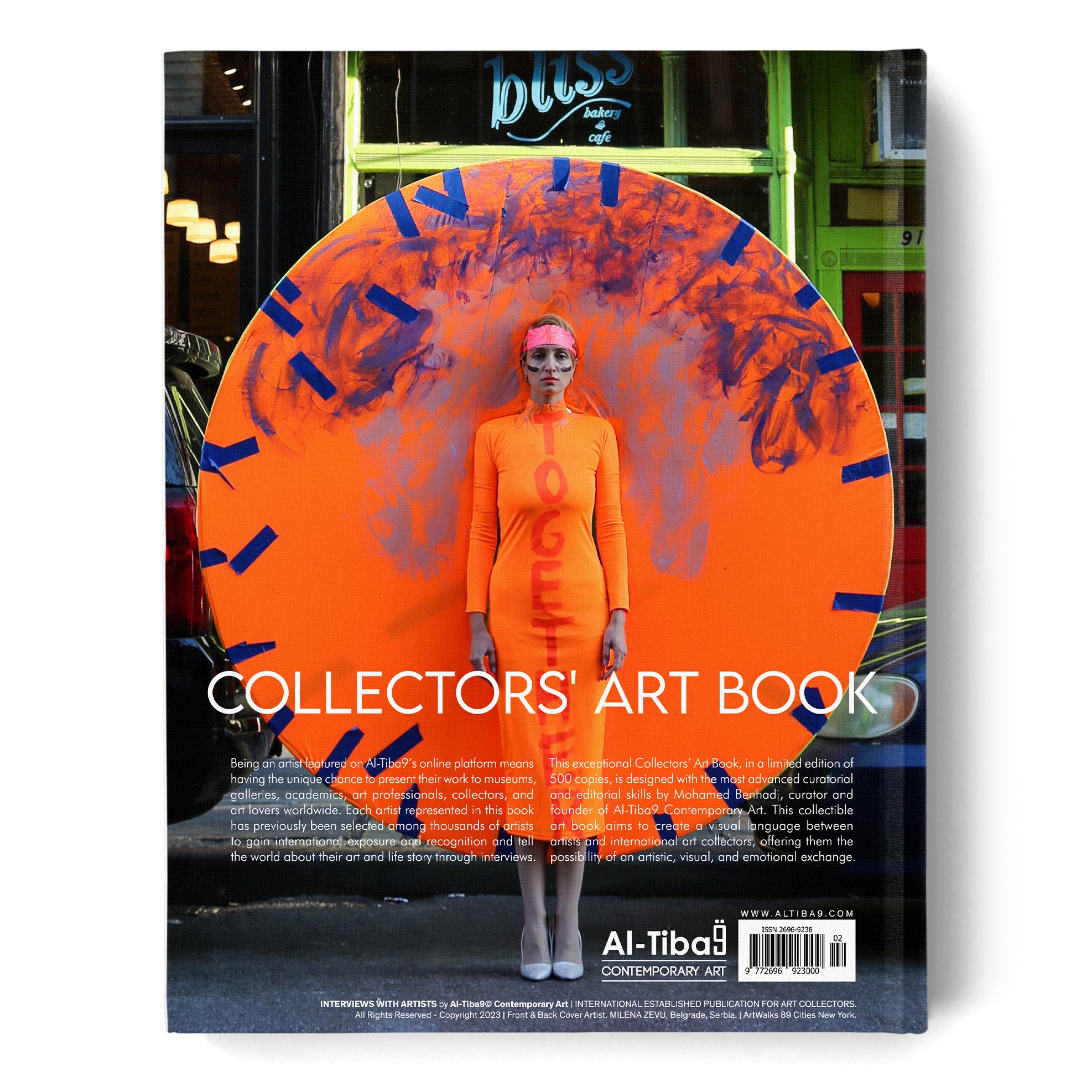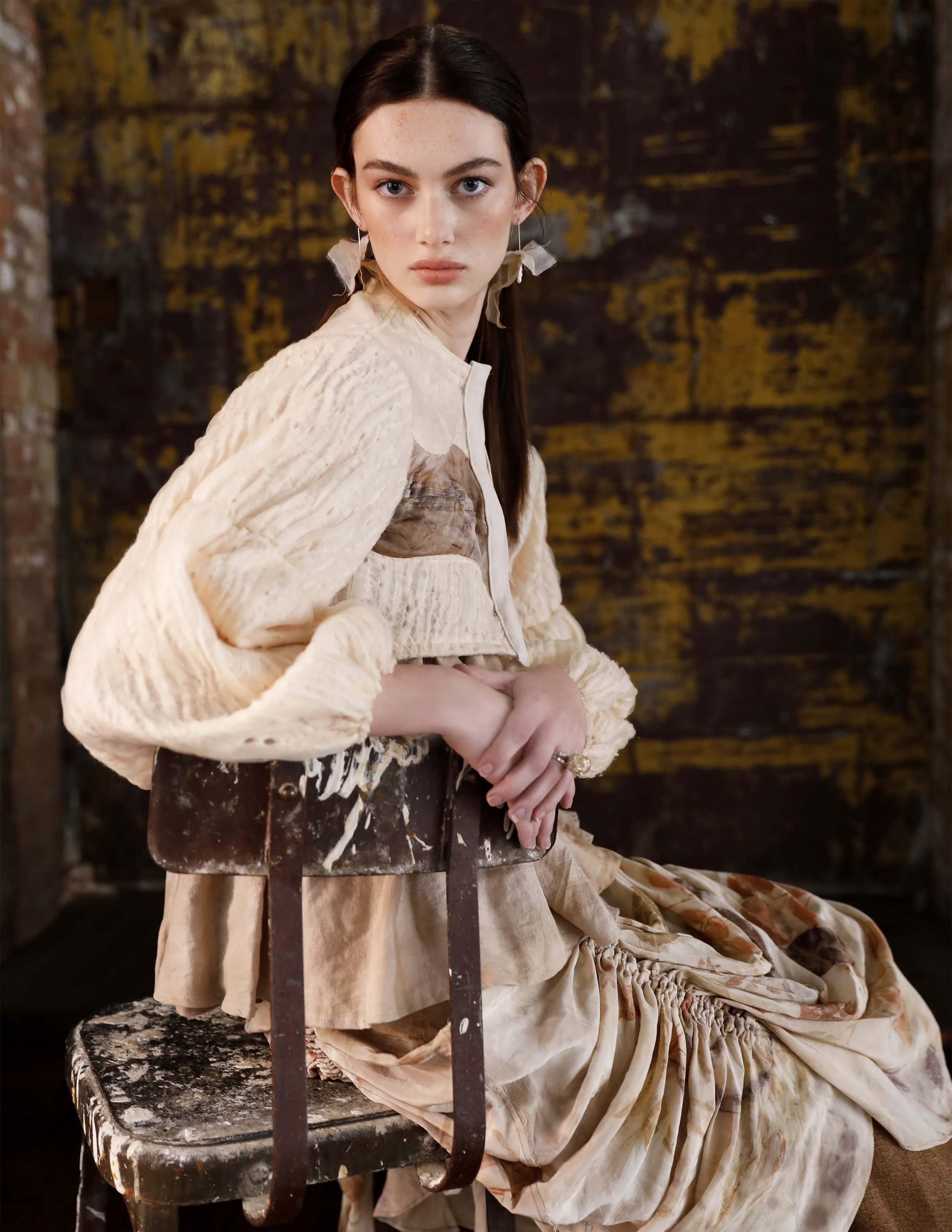10 Questions with YaXi Zhou
YaXi Zhou graduated from Savannah college of art and design with a degree in fashion design. Her works mostly focus on the emotional connection with human beings. In her early work "Motion", she combined people's abstract emotions with figurative objects and colors through interviews and research. In her recent works, she wanted to pay more attention to people's negative moods. Through her collections, YaXi strives to guide viewers to face their anxiety in a more positive way.
YaXi has always been committed to sustainable design, and she is currently working on using natural plants for fabric dyeing. She believes that to achieve sustainable fashion, besides the need of eco-friendly design, we also need to increase the usage of garments. Encouraging the audience to experiment with fabric dyeing will help increase the interaction between the users and the garments, building the emotional value of the object, thus making the garments more likely to be retained.
Currently, YaXi's collections have been published in several magazines, such as Pap and Flanelle. After receiving feedbacks from the audience, YaXi hopes to narrow down the inspiration for future designs from a large range of people to a specific group so that the works will have a deeper resonance and connection.
YaXi Zhou - Portrait
Free from Shadow | Project Description
Fashion designer YaXi's work Freedom from Shadow was inspired by people's anxiety regarding their appearance. She found that people inevitably have a fear of aging and the passing of life. This fear was reflected in a variety of beauty and health product advertisements. In the process of exploring the issue of "how to deal with appearance anxiety", she came across and experienced the Japanese dance called "Butoh". "Butoh originated in Japan after World War II. As a lot of Western culture was introduced to Japan, foreign dance forms like ballet greatly impacted Japanese dancers. However, Japanese dancers realized that they were not as slender as Western dancers. They evolved a dance, "Butoh," that suited their own physical characteristics. Rather than being a form of dance, Butoh can be seen as a form of performance art that expresses individual emotions. In contrast to traditional dance that expresses "beauty," Butoh presents a visual effect that may be painful, angry, or even negative. The dancers' twisted bodies and exaggerated facial expressions resonate with the audience and allow them to express their emotions. The designer was inspired by Butoh and wanted to design a project that allowed the audiences to accept and discover their own natural beauty.
By observing the naked skin texture of the dancers, the designer used the fabric to simulate the skin of the dancers. She also obtained the silhouette of the garment through the dynamics of the dancers. YaXi used the pleating technique to show the wrinkles and sagging of human skin during the aging process. These virtual "wrinkled" fabrics can be disassembled and reconstructed so that viewers can place them on any part of their bodies. The designer used plants to dye the silk. YaXi believes that freckles, wrinkles, and calluses are the body's record of personal stories. Through her designs, she hopes to encourage viewers to accept and even appreciate these imperfections in the "fabric skin". Thus, alleviating the anxiety about one's appearance and aging.
Yaxi claims that just as Butoh dancers didn't blindly worship Western dance culture and chose to develop a dance that suits their own body, people should look at their own appearance and discover their talents and strengths from this uniqueness. The "Freedom From Shadow" collection gives audiences a chance to have a dialogue with their own "imperfections", allowing them to confront the inevitable changes that occur in human appearance over time. Further, it enables viewers to explore the stories and experiences behind the physical changes as well as discover the power of individual freedom.
Freedom From Shadow, Photography, 2021 © YaXi Zhou
Get your limited edition copy now
INTERVIEW
Let's start talking a little about yourself. How did you first get interested in fashion design?
My initial interest in fashion came from Japanese fashion magazines. I was born in a small town in China, and during my childhood, social media was not as accessible as it is now. Print media was the main way I got fashion information. When I was in high school, I bought my first fashion magazine named ViVi. This magazine focused on Japanese street fashion, and I was fascinated by its advice on how to dress young readers. Since I couldn't buy all the items recommended in the magazine at that time, I started to use the clothes I already had to remake. "Remade with affordable items" was my first attempt at fashion design.
Why did you choose fashion specifically over other mediums as your creative outlet? What does fashion represent for you?
In addition to my personal interest in fashion, I believe that fashion is the most interactive form of artistic expression with audiences, which is one of the reasons why I chose it as a medium. The viewers can touch and wear the clothes in a more direct way. By feeling the fabric, people can better understand the ideas that the artist wants to convey. Unlike daily clothes, the experience of wearing a designer's fashion works may be "uncomfortable and unnatural", which is also a kind of emotional transmission. The viewers, by fitting the clothes and even participating in the process of making the clothes, also give their own values to the clothes, which is an interactive experience. Therefore, fashion means to me a process of exchange of values; it is not a single output or acquisition. When viewing a painting, a photograph, or a sculpture, the viewers may or may not agree with the artist's concept. Fashion gives the viewers the right to do something: they can accept or change different parts of the garment, reconstruct it or recreate it. The parts they keep represent an affirmation of the artist's ideas, and the parts they change contribute to the conversation with the artist.
Freedom From Shadow, Photography, 2021 © YaXi Zhou
Freedom From Shadow, Photography, 2021 © YaXi Zhou
Tell us more about your studies and work experiences. What are the experiences that shaped the designer you are now?
I spent my graduate studies in Savannah, a small town where the pace of life is slow. I often spend a lot of time thinking about exactly what kind of work I need to create. This slow pace allowed me to be usually very goal-oriented, and I could understand exactly what materials I wanted and what kind of experimentation I needed to do. After I started working as a designer in New York, the fast pace of life affected my designs as well. I had to experiment a lot in a short period of time. The fabric suppliers showed me a lot of samples of their latest fabrics. Unlike before, I witnessed a lot of waste and environmental destruction. For example, to protect animals, people often use faux furs. But most of them use dyes that pollute the environment. These fake furs are also difficult to decompose in the natural environment. Cotton, which is considered environmentally friendly, requires more water to grow than other plants. After seeing the truth behind a lot of "eco-friendly", I decided to move my designs in the direction of sustainability.
Let's talk about your creative process. How do you go from the first idea to the final collection? What are the fundamental steps you take to create a collection?
My inspiration always comes from the emotions that I really feel. In my previous design about "daydreaming", I analyzed and summarized some dreams of my own. But now I want to focus more on other people's emotions, or even the emotions of a group. Usually, I collect news and events that interest me most at this stage and select people around me to interview to get their similar stories and experiences. This information is often abstract. To get a better silhouette for the garment, I connect these stories and emotions with figurative objects. From the interviewer's story, I would look for key connected objects: anger and volcanoes, daze and mushrooms, anxiety and spots on the skin, etc. Then I would create mood boards, in which I would add some of my own ideas and rework the story through a visual presentation. I shape the silhouette of my design by extracting the brushes from the mood boards for practical comparison and final detailing.
Freedom From Shadow, Photography, 2021 © YaXi Zhou
How do you design your pieces? What are your influences, and who is your ideal customer?
In the design process, I usually consider the sustainability of the fabric itself, the environmental impact of the media in the production process, as well as the matchability and reorganization of the garments. My goal is to target middle-income consumers who are looking for quality of life and are concerned about environmental issues. I realized that the middle-income group is the majority of consumers in the fashion industry. However, at this stage, sustainable fashion products are very expensive and only a small group of people can afford them. Thus, I want to make my sustainable fashion affordable to more people.
You stress the importance of sustainable fashion, both with the materials you use and the techniques, such as natural dyes, and encouraging people to reuse the clothes. How did you get interested in sustainable fashion? And how important do you think it is for the survival not only of the planet but also of fashion as an art form?
My interest in sustainable fashion came from the period when I was studying in college. I noticed that at the end of each semester, fashion students always have many leftover fabrics and accessories. Most of the students donated the fabrics to the college or gave them to other students, but few of the students remake them, so most of them are stored in the warehouse. This phenomenon made me realize that even when creating just one collection of work, designers still need exponentially more materials. So, I want to minimize the waste of materials in the production process. I think sustainability is crucial for the fashion industry. From the consumer's point of view: sustainable fashion helps them to get longer-lasting, more organic products. And from a fashion artist's point of view, sustainable design is a slow-down lifestyle. Once the viewers embrace this idea of high-quality, slow fashion, it will stimulate artists to create better, more thoughtful work.
Freedom From Shadow, Photography, 2021 © YaXi Zhou
Freedom From Shadow, Photography, 2021 © YaXi Zhou
Speaking of sustainability, what practices do you implement in this regard in your production?
In my design, as I mentioned before, cotton needs more water to grow. To be sustainable, I selected silk as my main fabric. Since some of the silk fabrics are fragile and do not meet my expectation of "longer lasting wear", I mixed silk with linen to make the fabric more durable. I used Chinese herbs to boil and dye the fabric to create a uniform base color. The scent of the herbs remains on the fabric and helps protect it from insects. Then I used onion peel, pomegranate peel, chamomile, eucalyptus, and other plants to echo-print the fabric to create a colorful pattern. Finally, I used salt to fix the color to ensure the media will not pollute the environment and be harmful to the human body. Due to the randomness of the pattern, the wearer can use the plant remake to refurbish the garments and extend the durability of the clothes. The plants I used are very accessible and not too affected by seasonality, so consumers can easily access them at an affordable price. Through remaking, people create an emotional connection to the garment, which they cherish more and want to use for a long time.
Let's talk about your project, Freedom from Shadow, now. In your statement, you mention getting inspired by the Japanese dance called Butoh. Can you tell us more about it? And how did you incorporate this reference into your work?
The origin of Butoh came from the Japanese dancers' exploration of their own bodies. They allowed the dance to adapt to their body rather than the body to obey the dance. Butoh shows emotions, even negative, painful emotions, through exaggerated facial expressions and body forms. After I tried some Butoh dance, I felt it was more like a psychological treatment. Butoh has been a great inspiration to me, as it focuses more on the release of stress than on the gracefulness of dance posture and movement. I have noticed the emergence of a term called "beauty military service" in China, which means that people achieve "beauty standards" through uncomfortable and inconvenient ways: It means that people achieve the standard of so-called "beauty" through uncomfortable and inconvenient means: inconvenient nail art, mandatory makeup, and various plastic surgery procedures in response to people's anxiety about age. I hope people define themselves in terms of beauty rather than subjecting themselves to "beauty standards". My designs extracted the textures, imperfections, and even wrinkles from the skin to create the silhouette of the garment. In the process of wearing the garments, the viewers can feel the "aging", discover the beauty of natural body changes, and relieve the anxiety about the change of appearance.
Freedom From Shadow, Photography, 2021 © YaXi Zhou
Have you ever thought about starting your own brand? Or would you like to work for bigger, more established brands? And if so, would you lean more toward street style or luxury fashion?
Currently, I am planning to launch my own brand in 2023. I am leaning towards street-style fashion. As I said, sustainable products should not only be available to a small group of people. I want to focus on social issues and propose solutions and ways to solve them through fashion. I also want to get more people to pay attention to these concerns and get involved. Street style fashion can be affordable to more people, and I can also get more feedback from consumers to facilitate the exchange of ideas, which I believe helps me to consider it more deeply and get more inspiration.
Lastly, where can our readers see your work? Do you have any upcoming shows or publications you want to share with us?
More of my work process and artworks will be available on my personal website www.yaxizhou.com. I will also show my works using motion media to explain my fashion concept during the pandemic.

























